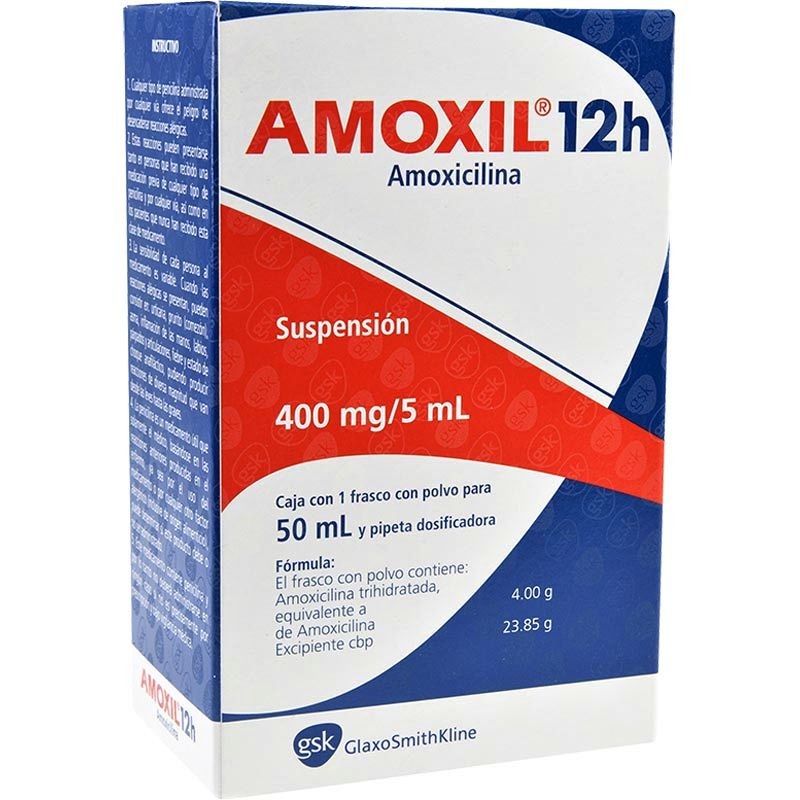
Amoxicillin Suspension 400 mg – Oral, Amoxil
Medication Uses How To Use Side Effects Precautions Drug Interactions Overdose Notes Missed Dose Storage USES: Amoxicillin is a penicillin-type antibiotic used to treat a wide variety of bacterial infections. It works by stopping the growth of bacteria. This antibiotic treats only bacterial infections. It will not work for viral infections (e.g., common cold, flu). Unnecessary use or overuse of any antibiotic can lead to its decreased effectiveness. HOW TO USE: Shake the bottle well before each dose. Take this medication by mouth with or without food, usually every 12 hours, or as directed by the doctor. You may add this medicine to formula, milk, juice, water, or ginger ale and drink it immediately. Drink plenty of fluids while using this medication unless your doctor tells you otherwise. Antibiotics work best when the amount of medicine in your body is kept at a constant level. Therefore, take this drug at evenly spaced intervals. Continue to take this medication until the full prescribed amount is finished even if symptoms disappear after a few days. Stopping the medication too early may allow bacteria to continue to grow, which may result in a relapse of the infection. Inform the doctor if your condition persists or worsens. SIDE EFFECTS: Nausea, vomiting or diarrhea may occur. If any of these effects persist or worsen, notify the doctor or pharmacist promptly. This medicine may cause temporary staining of the teeth. Proper brushing will usually remove any staining and may prevent it from occurring. Remember that your doctor has prescribed this medication because he or she has judged that the benefit to you is greater than the risk of side effects. Many people using this medication do not have serious side effects. Tell the doctor immediately if any of these highly unlikely but very serious side effects occur: dark urine, persistent nausea or vomiting, stomach/abdominal pain, yellowing eyes or skin, easy bruising or bleeding, persistent sore throat or fever. This medication may rarely cause a severe intestinal condition (Clostridium difficile-associated diarrhea) due to a type of resistant bacteria. This condition may occur during treatment or weeks to months after treatment has stopped. Do not use anti-diarrhea products or narcotic pain medications if you have any of the following symptoms because these products may make them worse. Tell your doctor immediately if you develop: persistent diarrhea, abdominal or stomach pain/cramping, blood/mucus in your stool. Use of this medication for prolonged or repeated periods may result in oral thrush or a new vaginal yeast infection (oral or vaginal fungal infection). Contact the doctor if you notice white patches in your mouth, a change in vaginal discharge or other new symptoms. A very serious allergic reaction to this drug is unlikely, but seek immediate medical attention if it occurs. Symptoms of a serious allergic reaction may include: rash, itching/swelling (especially of the face/tongue/throat), severe dizziness, trouble breathing. Amoxicillin can commonly cause a mild rash that is usually not serious. However, you may not be able to tell it apart from a rare rash that could be a sign of a severe allergic reaction. Therefore, seek immediate medical attention if you develop any rash. This is not a complete list of possible side effects. If you notice other effects not listed above, contact the doctor or pharmacist.In the US -Call your doctor for medical advice about side effects. You may report side effects to FDA at 1-800-FDA-1088.In Canada – Call your doctor for medical advice about side effects. You may report side effects to Health Canada at 1-866-234-2345.
PRECAUTIONS: Before taking amoxicillin, tell your doctor or pharmacist if you are allergic to it; or to penicillin or cephalosporin antibiotics; or if you have any other allergies. Before using this medication, tell the doctor or pharmacist your medical history, especially of: kidney disease, a certain type of viral infection (infectious mononucleosis). Kidney function declines as you grow older. This medication is removed by the kidneys. Therefore, elderly people may be more sensitive to this drug. This medication should be used only when clearly needed during pregnancy. Discuss the risks and benefits with your doctor. Amoxicillin passes into breast milk. Consult your doctor before breast-feeding. DRUG INTERACTIONS: Your doctor or pharmacist may already be aware of any possible drug interactions and may be monitoring you for them. Do not start, stop, or change the dosage of any medicine before checking with them first. Before using this medication, tell the doctor or pharmacist of all prescription and nonprescription/herbal products you may use, especially of: allopurinol, live bacterial vaccines, methotrexate, tetracyclines. Before taking amoxicillin, tell your doctor or pharmacist if you are also taking probenecid. Probenecid slows down the removal of amoxicillin from your body, resulting in higher levels of this antibiotic in your bloodstream. For certain types of difficult-to-treat infections, your doctor may prescribe these 2 medications together in order to achieve this effect. Consult your doctor or pharmacist for more details. This medication may decrease the effectiveness of combination-type birth control pills. This can result in pregnancy. You may need to use an additional form of reliable birth control while using this medication. Consult your doctor or pharmacist for details. Amoxicillin may cause false positive results with certain diabetic urine testing products (cupric sulfate-type). This drug may also affect the results of certain lab tests. Make sure laboratory personnel and the doctors know you use this drug. This document does not contain all possible interactions. Therefore, before using this product, tell your doctor or pharmacist of all the products you use. Keep a list of all your medications with you, and share the list with your doctor and pharmacist. OVERDOSE: If overdose is suspected, contact your local poison control center or emergency room immediately. US residents can call the US national poison hotline at 1-800-222-1222. Canadian residents should call their local poison control center directly. Symptoms of overdose may include: severe vomiting, persistent diarrhea, a severe decrease in the amount of urine or seizures. NOTES: Do not share this medication with others. This medication has been prescribed for your current condition only. Do not use it later for another infection unless told to do so by the doctor. A different medication may be necessary in those cases. With prolonged treatment, laboratory and/or medical tests (e.g., kidney and liver function, complete blood counts) should be performed periodically to monitor your progress or check for side effects. Consult the doctor for more details.
QUESTION
MISSED DOSE: If you miss a dose, take it as soon as you remember. If it is near the time of the next dose, skip the missed dose and resume your usual dosing schedule. Do not double the dose to catch up. STORAGE: Refrigeration may improve the taste of this medicine but may not be required. Certain brands of this medicine may expire earlier when stored at room temperature than when refrigerated. Check the bottle or ask your pharmacist to see if (and for how long) you can store this medicine at room temperature. Do not store in the bathroom. Keep all medicines away from children and pets. Discard any unused portion after 14 days since the drug loses potency after that time. Do not flush medications down the toilet or pour them into a drain unless instructed to do so. Properly discard this product when it is expired or no longer needed. Consult your pharmacist or local waste disposal company for more details about how to safely discard your product.
Report Problems to the Food and Drug Administration
You are encouraged to report negative side effects of prescription drugs to the FDA. Visit the FDA MedWatch website or call 1-800-FDA-1088.
Selected from data included with permission and copyrighted by First Databank, Inc. This copyrighted material has been downloaded from a licensed data provider and is not for distribution, except as may be authorized by the applicable terms of use.
CONDITIONS OF USE: The information in this database is intended to supplement, not substitute for, the expertise and judgment of healthcare professionals. The information is not intended to cover all possible uses, directions, precautions, drug interactions or adverse effects, nor should it be construed to indicate that use of particular drug is safe, appropriate or effective for you or anyone else. A healthcare professional should be consulted before taking any drug, changing any diet or commencing or discontinuing any course of treatment.


